| George H. W. Bush (1983: Doomsday) | |||
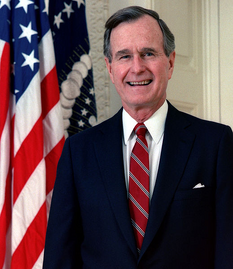 | |||
| Official Portrait, 1985 | |||
| 41st President of the United States | |||
| In office | |||
| May 8, 1984 – May 1, 1995 | |||
| Vice President: Robert D. Nelsen | |||
| Preceded by: Ronald Reagan | |||
| Succeeded by: Ray Hunkins (retroactively recognized as the 42nd President | |||
| 43rd Vice President of the United States | |||
| In office | |||
| January 20, 1981 – May 8, 1984 | |||
| President: Ronald Reagan | |||
| Preceded by: Walter Mondale | |||
| Succeeded by: Robert D. Nelson | |||
| Personal details | |||
| Full Name: George Herbert Walker Bush | |||
| Born: June 12, 1924 Milton, Massachusetts | |||
| Died: November 30, 2018 Canberra, Australia | |||
| Resting place: Torrington, DK, USA | |||
| Political party: Republican | |||
| Spouse: Barbara Pierce Bush | |||
| Children: George Walker Bush Pauline Robinson Bush John Ellis Bush Neil Mallon Bush Marvin Pierce Bush Dorothy Bush Koch | |||
| Alma mater: Yale University | |||
| Occupation: Businessman (Oil) | |||
| Religion: Episcopalian | |||
| Military service | |||
| Allegiance: United States of America | |||
| Service/branch: United States Navy | |||
| Years of service: 1942-1945 | |||
| Rank: Lieutenant, Junior Grade | |||
| Unit: Fast Carrier Task Force | |||
| Battles/wars: World War II | |||
| Awards: Distinguished Flying Cross Air Medal (3) Presidential Unit Citation | |||
George Herbert Walker Bush (June 12, 1924—November 30, 2018) was the 41st President of the United States (1984-1995) best known for leading the American Provisional Administration in the Pacific Ocean during the decade following Doomsday in the United States. Before his presidency, Bush served as Ronald Reagan's Vice President (1981–1984), a US Congressman, an ambassador, and Director of Central Intelligence. Bush also led the Republican National Committee during the early 1970's.
In 1980, Bush declared his candidacy for the Republican nomination for President of the United States. Bush's main competition in the primaries was former California Governor Ronald Reagan. Eventually, Reagan triumphed and was declared the GOP nominee. Reagan asked Bush to be his running mate, and despite representing two different wings of the Republican Party, the two developed a strong working partnership.
After the death of Reagan, Bush became the President. During his presidency, Bush had to face the monumental and unenviable challenges of leading the remnants of the US government, after the country's collapse. President Bush was faced with many gut-wrenching and controversial decisions, and many continue to arouse much controversy. This began immediately after his swearing-in, when he decided to leave his relocation site in Colorado and go to Hawaii, where he could follow Reagan's plan to get help from America's ANZUS allies and win the North Pacific War. The controversy extends to the very end of his administration, when Bush decided to disband the APA and cede America's responsibilities in the Pacific to Australia and New Zealand.
Nevertheless, Bush remained engaged with the American refugee community after his presidency ended and took strides to ensure the preservation of American culture among the American refugee communities in the Commonwealth of Australia and New Zealand and throughout the Pacific.
As regular and reliable communication became possible between Oceania and the Provisional United States in the Rocky Mountains and Great Plains, Bush took steps to support them as the legitimate successors of the original US government. He spent much of his efforts during his last years doing what he could to advise and support the reborn United States of America.
Pre-Doomsday[]
Bush was born in Massachusetts to Senator and New York Banker Prescott Bush and Dorothy Walker Bush. Following the attacks on Pearl Harbor in 1941, at the age of 18, Bush postponed going to college and became the youngest naval aviator in the US Navy at the time. He served until the end of the war, then attended Yale University. Graduating in 1948, he moved his family to West Texas and entered the oil business, becoming a millionaire by the age of 40.
He became involved in politics soon after founding his own oil company, serving as a member of the House of Representatives, among other positions, such as as the Chief Liaison to China, head of the Republican National Committee, and Director the Central Intelligence Agency during the turbulent 1970's.
Bush ran unsuccessfully for president of the United States in 1980, but was chosen by party nominee Ronald Reagan to be the vice presidential nominee; the two were subsequently elected.
During the Reagan presidency, the two men, despite representing different wings of the Republican Party, grew to respect each other and developed a very strong working relationship. Bush's diplomatic experience served a useful function for the Reagan Administration in its negotiations with other nations.
These diplomatic skills would prove to be even more valuable in just a short time.
Doomsday[]
Life at the Greenbrier[]
With some warning of the imminent Soviet nuclear attack, the Secret Service was able to relocate Bush and his wife Barbara to the Greenbrier Hotel facility in White Sulfur Springs, West Virginia. The Secret Service had also been able to scoop up a small number of the higher-ranked members of Congress and transported them to the Greenbrier as well. Those evacuated included the leaders of the two chambers of Congress, Tip O'Neill and Strom Thurmond; as people in the constitutional line of succession to the presidency, they played a key role in the United States' continuity of government plans. It had been hoped that they could safely rescue more members of Congress, but a tragically large number of Senators and Representatives had either been too far away for it to be practical for the Secret Service to rescue them, or the Secret Service had been unable to verify their locations in time to pick them up.

The Greenbrier facility.
Nevertheless, the Bushes and the few surviving members of Congress settled into their new home and began communicating with President Reagan and most of the Cabinet members, who were situated at the Mount Weather Emergency Operations Center. The facility, however, only had limited resources, especially since the relocation had to be accomplished hurriedly after the Soviet surprise attack.
Bush and Reagan agreed that the best course of action was to divide the administration so that they could concentrate on rebuilding different parts of the country. Reagan would go to Hawaii, which had the most direct access both to the Soviet Union and America's strongest remaining allies, New Zealand and Australia. Bush would go to Colorado to work close to the NORAD facility at Cheyenne Mountain. O'Neill, a close friend, would go along, as would a few Cabinet secretaries with roots in the intermountain west. Thurmond and a few Cabinet secretaries would stay behind in Appalachia; it was hoped that another group could eventually would go to the Caribbean to support the ongoing war against communist Cuba.
Charleston and Leadville[]
Bush left the bunker on April 23, 1984 and met with President Reagan in Charleston, West Virginia. The state capital was struggling, but it had survived, and it would serve as the new capital of the U.S. Administration– East under Thurmond. It was the first time that Bush and Reagan had seen each other in six months, and they knew it would likely be the last time for at least as long. They had several long meetings and made a few brief public appearances. A new emergency plan was drafted and sent to NORAD, which had the responsibility to disseminate it to any surviving state and federal entities in the immediate region. After that, Bush and Reagan separated. Air Force Once was bound for Hawaii by way of Mexico, while Bush flew in Air Force Two to Leadville, Colorado.
Leadville had much to offer as an emergency capital. It was close enough to NORAD for easy communication and reasonably easy movement back and forth. Its altitude - more than ten thousand feed above sea level, both the highest incorporated city and highest commercial airport in the country - provided a sense of security and made it a kind of natural fortification. That same airport had a runway more than long enough to handle a Boeing 707, which Air Force One and Two both were. It had equipment that could communicate with Cheyenne Mountain. And while an airport was certainly no military base, it was still fenced in, so could be made secure. For more comfortable accommodations and office space, Leadville also had a residential community college that was going unused. Most importantly, the city was above and upwind of the crippling nuclear strikes on the Great Plains missiles and Colorado's Front Range, so it had not been blanketed with fallout.
Bush landed on May 6, now with the additional title of Acting President— West. It took only a few minutes' inspection to determine that the airport's cramped one-room "terminal" would be far from adequate. Workers were dispatched to Colorado Mountain College to begin converting it into a makeshift federal complex. Bush spent the next few days living and working mostly in the plane. He met with the mayor and city council, but he had not yet made a public appearance when the news arrived: all contact had been lost with President Reagan. Bush was shaken by the news and requested that they wait a few days, but on May 11, he was sworn in as the 41st President of the United States of America by the Chief Judge of the 5th Judicial District of Colorado.
Presidency (1984-1995)[]
Exodus to Mexico and a Family Reunion[]
Reagan's disappearance cast a pall over Bush's administration from the beginning. As he took the Oath of Office in the Lake County Courthouse, he was wondering what his course of action should be. Reagan had believed that the President should be in the Pacific. Reflecting on his own service there during the last world war, Bush worried that he now was needed out there to complete the mission set by his predecessor.
The situation in the Rockies did not fill him with confidence. It was clear that NORAD's headquarters would not last forever. Already it was fighting periodic power outages and disruptions to communications. Outside a few remote valleys like Leadville, Colorado was blown to bits. Montana wasn't much better. Utah was apparently already coming under the theocratic rule of the Mormon Church. Wyoming was the only functioning state government left, now based in Casper, and it was hard to see how either the President or NORAD could help it at the moment. Bush very soon decided that hiding in the Rockies was no better than hiding in the Appalachians. He resolved to go to Hawaii, leaving O'Neill as Acting President for the western mainland.
The plane, now designated Air Force One, landed in Mexico City on May 28. There would be no public ceremony, as Reagan had had when he passed through weeks before. Bush made time only for a terse meeting with President de la Madrid devoted to matters of American refuggees and communication between Hawaii and Mexico - and a bittersweet reunion with Bush's son. George W. Bush and his family had survived Doomsday and had managed to make it to Mexico City. Bush had at the last minute contacted his children before leaving for Mount Weather to warn them of the coming attack. So far, however, only his eldest son had been confirmed to still be alive. The reunion had to be brief. The President insisted that he not accompany him to Hawaii, thinking about what had befallen Ronald Reagan. The younger Bush and his family would eventually move to Hawaii to join Bush, Senior a few years later.
On May 30, Air Force One flew to Hilo, safely landing at General Lyman Airfield. He would never again set foot on the American continental mainland during the years of his presidency.
American Provisional Administration[]

President Bush's speech announcing the formation of the American Provisional Administration.
President Bush moved quickly to establish the American administration in the Pacific. Secretary of State George Shultz met him at the airport together with Colonal David E. K. Cooper, the commander of federal troops on the Big Island, Louis Goldblatt, the agricultural union boss serving as Hawaii's de facto emergency governor, and the newly-arrived ambassadors from New Zealand and Australia. They accompanied Bush into the city, where he announced the creation of the American Provisional Administration (APA), located out of the Hilo Federal Building. The goals of the organization were threefold: first, to gather intelligence on the situation, both in the USA and across the world; secondly, to provide cohesion for the community of American survivors; and thirdly, to respond to ongoing Soviet threats in Alaska and around the Pacific. The lack of fuel and food available made all of this a daunting task, and the administration would have to rely on aid from Australia and New Zealand.
In June 1984, President Bush, along with Prime Minister Hawke of Australia and Prime Minister Muldoon of New Zealand, issued the Gathering Order. The Gathering Order was issued to all remaining US and NATO forces to set sail for Australian, New Zealand and Hawaiian waters and submit themselves to command of ANZUS. The president also prioritized the re-establishment of communication and supply lines with the far flung American outposts in the Pacific Ocean. Negotiations with the Australian government were successful in gaining access to Australian funds and supplies to be used by the APA.
Bush and Shultz stayed in Hawaii long enough to celebrate Independence Day, but soon after they departed for Australia to meet in person with their Australian counterparts and American naval officers. An Australian plane flew them to Brisbane, designated the location of the new ANZUS military command. Bush stayed in Australia a few weeks, then went to Auckland for another round of meetings. On his way back to Hawaii, he stopped in American Samoa for a high-profile public appearance to confirm the islands' loyalty to the APA. Bush would spend a good deal of his presidency away from Hilo, leaving subordinates in charge of things in the provisional capital. These frequent travels were necessary for his work, but they also served to alienate him from the Hawaiian people. Already on December 8, he made his second trip to Australia to be on hand to greet the USS Carl Vinson when it arrived in Brisbane.
The arrival of so many American warships was a boon in securing the supply lines to the scattered outposts of the old USA. Throughout the late 80s and early 90s the APA was able to supply food and medicine from Australia and New Zealand to these last remnants of America.
Ending World War III: Alaska 1985-6[]
ANZUS successfully carried out its primary mission: liberating Alaska, eliminating the Soviet threat to the Pacific, and finally putting an end to World War III. A large naval force arrived off Juneau late in 1984. In the spring and summer of 1985, it cleared most of Alaska of the poorly-organized Soviet occupiers, confining them to a few remote islands in the western Aleutians. This success in what was called the North Pacific War served to link Alaska closely to the Administration and view it as a liberator. Bush visited Juneau and toured southeastern Alaska in 1986 and was greeted enthusiastically. The following year, Shultz went to Alaska to negotiate the Sitka Accords, bringing a formal end to the war that had wiped out half the world.
Operation Tropical Storm: Hawaii 1988[]
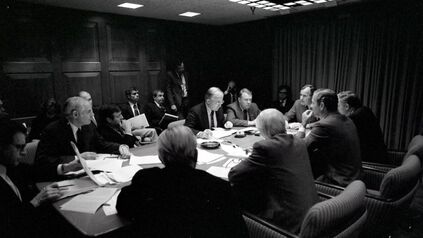
At the Situation Room in the US Embassy in Canberra, President Bush is briefed by his advisors on the growing crisis in Hawaii in 1987.
In 1987, Governor Goldblatt of Hawaii was assassinated, throwing the islands into a crisis. Bush, as he was so often, was off-island at the time, meeting with Australian officials in Canberra. From their redoubt in Pohukaloa, U.S. forces were able to occupy the capital quickly enough, but Goldblatt's supporters and opponents continued to fight in the countryside and on Maui.
Bush decided that his personal attention was needed. He decided that he would return to Hawaii himself to restore order, accompanied by Australian and US troops. The ANZUS military leaders drew up plans for what they called Operation Tropical Storm. Contact between Hawaii and Australia in those days was still spotty, and Bush expected to find Hawaii in a state of civil unrest that he could calm with the weight of his own authority. Instead, he and his team stepped into an all-out civil war that put the President in great personal danger.
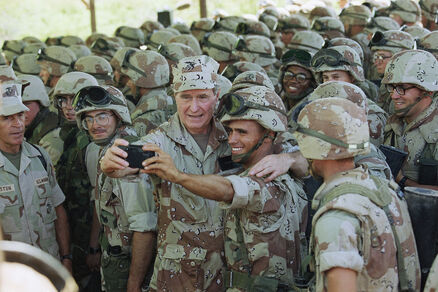
President George Bush travelling with US troops during Operation Tropical Storm in Hawaii in 1988.
The reinforcements began landing at the army airfield early in 1988. Bush came with a later military airlift, fully taking on the role of Commander in Chief. Though he did not actively take part in the military decision-making of the mission (entrusting those decisions to the military commander of the operation), Bush traveled among the soldiers and civilians, talking with them and keeping morale up. His presence, and the large ANZUS force, indeed took momentum away from the guerrillas. Bush was able to return to Hilo after a few weeks of fighting.
Once more in the Federal Building, Bush signed an order declaring Hawaii to be under emergency federal control. The reinforced federal troops restored order through a mix of force and the promise of new, free elections. The success of Tropical Storm helped bolster sagging American morale among the survivors across the Pacific. Americans in Hawaii and across the Pacific were invigorated by the sight of their President personally putting himself at risk, giving them hope that they could past the horrors of the post-Doomsday years.
However, not all Hawaiians happy with the result of the conflict. It was no secret that the conservative Bush administration had not gotten along with the Goldblatt regime - a labor union that had taken over the running of the state. Comments by Bush and members of his cabinet had been reported by the press deriding it as "communist" and little better than "a Russian invasion". Rumors continued to swirl - and still do today - that the APA was responsible for the governor's murder.
Election of 1988[]
On January 24, 1988, Bush announced in a radio address that presidential elections would still be held on November 8, 1988. He stated that America was founded on the principal of democratic government and to give it up now, even in the face of nuclear holocaust, would be a death blow to the country. The announcement came as a surprise to everyone in those territories governed by the APA. It was also criticized as a waste of resources.
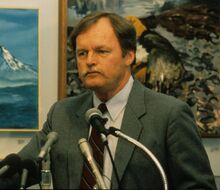
Steve Cowper of Alaska, the Democratic nominee for President in 1988.
Nevertheless, the Republican party held a small convention in Kahului, Maui where Bush was unanimously chosen to be their candidate. The remnants of the Democrats had their own convention a few days later and nominated Alaskan politician Steve Cowper. Bush remained a popular figure in Alaska, but there was still plenty of cause for criticism. Most obvious was his decision not to liberate the remaining islands, but Alaskans also complained that since the end of the war, the APA had neglected Alaska in favor of Hawaii and the territories. Still, many Democrats admitted that the only reason they nominated Cowper was so that Bush would not run unopposed for president, something that only George Washington ever had the honor of.
The general election campaign between the two men has been described as one of the most civil in American history. Though Cowper criticized Bush for some of the actions of the APA in Alaska and Hawaii, he lauded him for his efforts in ending the war and maintaining the United States after Doomsday. Bush also praised Cowper for his actions in helping reestablish the Alaskan state government in 1985.
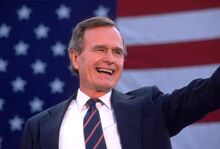
George HW Bush in 1988 after winning reelection as President.
On November 8, 1988, with over 50% of registered voters voting, Bush was reelected President of the United States of America. In his victory speech, Bush promised to continue to work to rebuild America. His speech also contained his famous pledge: "the light of America will never be extinguished." Bush also promised to establish APA control over survivor communities in Washington, Oregon and California and help preserve American culture.
Election of 1992[]

By the 1992 election, the increasing difficulties faced by the APA (particularly the fact that it had thus far not managed to restore order to the American mainland) as well as personal doubts about whether he should run again (and become the first President since FDR to surpass 8 years in office) made Bush reluctant to run again. Nevetheless, APA officials convinced him that a familiar face was needed.
By 1992, however, Bush was growing increasingly exhausted, a fact that his advisors all seemed to notice. Although he'd been buoyed during the 1988 election by the afterglow of the successful military operations in Alaska and Hawaii, by 1992 the situation for the APA was growing increasingly difficultas it struggled to deal with economic problems in the Pacific, as the independence movement started to grow again in Hawaii in the midst of that economic crisis, and as the APA had thus far failed to reassert itself on the North American mainland.
Furthermore, according to several advisors in interviews given many years later, President Bush was personally conflicted about whether he should or could run for another term in 1992. In 1984, he had considered himself carrying the torch for Ronald Reagan's unfinished term at a time when the situation was too chaotic for an election to be held. In 1988, he had outright won an election in his own name. But if he ran and won in '92, he'd be the first President since FDR to go beyond 8 years. Bush was reportedly considering stepping down, but APA officials and Australian legal scholars convinced him that the post-Doomsday term he'd served from '84 to '88 had been under an extraordinary circumstance and that he could therefore run again. The APA officials further pressed that Americans needed to see a familiar face in charge, at least until the APA could return to restore order on the American mainland.
Reluctantly, Bush declared his candidacy for another term as President. But this time would not be as easy as the last.
As a result of the increasingly visible problems facing the APA and lack of progress in reclaiming the mainland, Bush's Democratic opponent in 1992 would be much more eager to challenge him and mount a much feistier campaign than Cowper had in '88.
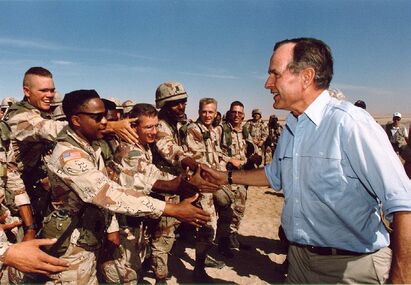
President Bush visits American troops during training exercises in the Outback, 1990
Crescent City Crisis[]
Desperate to meet his campaign promises in the face of growing dissent, Bush pressured APA officials to re-establish federal control among the survivor communities of southern Oregon and northern California. Despite refusals by the local leader, "Boss Jones," the APA established a base at Del Norte County Airport near Crescent City, California. In April, Boss Jones and followers launched a surprise attack on the base, taking hostage many APA agents and killing the small Marine guard that was sent to protect them.
News of the attack led to widespread outrage among Americans in Oceania. President Bush quickly ordered a rescue mission to be carried out by American special forces was mounted. Though the mission successfully freed the hostages, several of the hostages were killed, as well as over 200 civilians in Crescent City during a bombing run on the town's defenses. "Boss Jones" survived, but the real blow was to the American Provisional Administration, because it showed a key weakness of the APA projecting power from ANZC to the former USA.
In the aftermath of the crisis, the towns of the region became openly hostile to the APA. Attempts to establish another APA base were rebuffed, sometimes violently. Public opinion of the APA dropped dramatically. President Bush would later go on to say that the Crescent City Crisis caused him to seriously consider proposals about disbanding the APA.
End of the APA[]
The Crescent City Crisis was the first triggering event that led to the end of the American Provisional Administration. The second came in November 1994, when Hawaiians voted to secede from the Union and become an independent country. The vote was a shock despite following years of mounting tensions between the APA and the Hawaiian people. Bush decried it as illegal and asked New Zealand and Australia, once again, for help in pacifying one of his own states. This time, both governments said no. Instead they insisted on meetings to redefine the role of the APA and the mutual relationships among all the Pacific nations.
On May 1, 1995, after six months of negotiations, Bush announced in front of the American embassy in Wellington the immediate end of his presidency and the future end of the APA. In consultation with Prime Ministers Mike Moore and John Howard, Bush issued a short statement to a crowd of American expatriates and forces stating that it is best if they "become part of the Australian life and culture". He explained how he would continue to act as an adviser to Howard, primarily on development of Australian oil production in Indonesia and Papua.
Though the United States of America had officially come to an end in the Pacific, Bush stressed in his speech that he had hope for the country. In what became known as the “Continuity Act”, Bush declared that the United States sovereignty and Constitution were only “temporarily suspended until a legitimate successor – continuing the US traditions of Freedom and Democracy - is elected by the American people." By this time he was aware that the administration left behind in Colorado had evolved into a new federation; and while no one in the Pacific could be clear on the details, they knew that the Provisional USA would have to carry on the American legacy alone.
Disbanding the APA proved to be the most controversial decision in Bush's presidency. Constitutional debates about whether Bush had this authority led to the establishment of the Committee to Restore the United States of America by American expatriates in Australia.
Post-Presidency[]
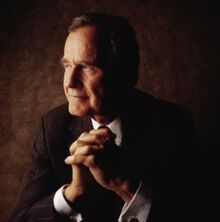
No longer President of the United States, Bush moved permanently to Australia. He was present on August 15, 1995 on the celebrations commemorating the creation of the Commonwealth of Australia and New Zealand as the successor to ANZUS. As one of the many speakers at the occasion, Bush announced that the ANZC could be the successor to the United States that he and other Americans were hoping for. Not all Americans, however, were supportive of this development. The Committee to Restore the United States of America felt that Bush had betrayed the country by disbanding the APA and throwing his support behind the ANZC. Bush continued to remain an advisor to the leaders of the Commonwealth on American affairs.
The book that may do the most to shape Bush's final legacy in the public memory was published in 2000. The Last American President, by historian William Feston, is a sympathetic biography focusing on the President's resilience in the Aftermath era, and on the intense personal struggles he felt during his key decisions, from requesting to be sworn in as President in Canberra, to disbanding the APA a decade later. The Last American President has been widely read by surviving Americans wherever it has been made available, even on the American mainland, where in many communities it is practically the only piece of post-Doomsday literature that can be found. Bush himself approves of the book and convinced Feston and his publisher to donate their profits and royalties to the United States History Museum.
Though not present for the signing of the Municipal States of the Pacific Contract on July 4th, 2006 at Crescent City, Bush commented that: “The seed of the spirit of the United States has survived on U.S. soil. Maybe one day our glorious heritage will be continued ..." This was the first time Bush had publicly spoken on American nationalism since 1995.
Bush remained prominent in international affairs throughout his life. In 2007, he was one of the many dignitaries who helped negotiate the creation of the League of Nations. He was especially helpful by acting as an arbitrator of disputes between the ANZC and the South American Confederation.
Ever since the 2009 Field Expedition brought back detailed information on the large number of American survivor states in the interior of North America, Bush has once again spoken out in favor of American nationalism. Exactly what this would mean for Bush's future political career became a very widely-discussed topic among political observers.
When US President Allard applied for membership in the League of Nations, there were certain political elements that vehemently tried to block diplomatic recognition of the reborn USA. It was ultimately former President Bush who helped turn the tide in Allard's favor. Bush made a surprise appearance at the LON headquarters on Tonga and requested time for a speech. Secretary-General George Tupou granted him time, and Bush approached the podium.
One member of the ANZC delegation gave the following description of the momentous event to reporters:
Everyone was craning their necks to see him, whispering to their fellow delegates with a mixture of curiosity and shock. The former President was now much older, and walked with the help of a cane. The Secretary-General helped him climb the steps to the podium. Now the crowd fell silent. Bush put on a pair of spectacles and surveyed the crowd quietly. Then he spoke.
Bush confirmed the validity of President Allard's claims of continuity with the old U.S. government. He told the story of his short time in Colorado and all the failures and setbacks that the leaders there faced. President Bush then paused, looked at the delegates again, and expressed that when he'd given the order to disband the APA in '95, it seemed that he had exhausted all options to salvage the American homeland from the Pacific. All that was left was faith that others in the interior could continue the task. Now here were survivors who had elected new leaders, followed the principles of the US Constitution, and were restoring the nation on US soil. President Bush said that in light of these facts, he strongly urged the LON member states to extend diplomatic recognition to the reborn United States.
I may be an Aussie, but I know for a fact that this was an epochal moment for Americans. Former President Bush had come to the rescue of his successor, like a knight on horseback in one of those old timey stories, and successfully helped the reborn United States of America take its place among the nations of the world.
And I'll never forget how Bush ended his speech. He referenced the name of the world-famous biography that had been written about him, but he sacrificed the title it had given him, sacrificed it for the good of his country: Bush, by now energized and forceful, declared to the assembled delegates that "1995 was not the last American year. The generation that lived through Doomsday was not the last American generation...
...and I am NOT 'the Last American President!'"
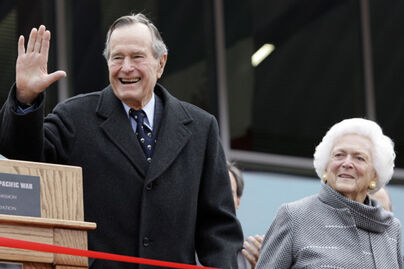
Bush leaving the League of Nations headquarters on Tonga with his wife Barbara after making his famous speech in favor of the restored United States.
At this declaration, the various delegations all reacted. The reception was mostly positive, although members of the socialist delegations, such as from Siberia and Cuba, predictably reacted with jeers. But the members of the US delegation and the delegations of various US-friendly governments such as the ANZC, gave President Bush a standing ovation.
This was especially notable, since the American delegation had been ambivalent to Bush before due to his decision to end the APA. However, as commentators would later note, this speech almost single-handedly mended the bridges between the Bushes and the restored US government.
George H. W. Bush then made his way down from the podium and famously embraced President Wayne Allard. With that speech and that now-famous photo of the Bush-Allard embrace, Bush had helped raise the stature of the Torrington government and signaled his endorsement of Wayne Allard and the other new Presidents as his legitimate successors.
Many commentators have noted that President Bush's appearance at the League of Nations that day almost single-handedly reversed the negative perception of him among many CRUSA members and other Americans who had disapproved of his disbandment of the APA. Commentators would also note that it ensured a political future for President Bush's son, George W. Bush. As news, photos, and radio reports of the speech spread, Bush's popularity among mainland Americans was restored. Soon, discussions even began of a possible visit by Bush to Torrington, the new U.S. capital.
The former President continued to make many public appearances. Recently he appeared on an Australian fishing television show. He continued to live in Canberra, Australia with his wife Barbara.
Return to the USA[]
In the aftermath of his speech at Tonga, Bush's reputation soared once again among mainland Americans and the American diaspora. Bush continued to make speeches in support of the new government, and chaired meetings between representatives of the US government and the American Diaspora Committee in the ANZC. Former President Bush was also on hand for the official reopening of the US Embassy in Canberra as it resumed its former diplomatic status. Eventually, Bush was invited to make his first trip to Torrington, with the tour scheduled for the summer of 2012, with Bush slated to make a speech during Torrington's Fourth of July festivities.
Bush departed from Australia in spring of that year and arrived at Newport, Oregon to great fanfare, with the Governor of Oregon leading a welcoming party. Curious crowds had gathered, and cheered as the former President set foot on the American mainland for the first time since 1984. Bush was visibly overwhelmed with emotion at returning to America for the first time in decades, and made an emotional speech to the electrified crowd.
Former President Bush was traveling with his wife Barbara, son George Walker Bush, daughter-in-law Laura, and granddaughters Barbara and Jenna. Together, the Bush family was given a tour of the city, including visiting the planned site of the New Statue of Liberty. Bush was given the honor of laying the cornerstone for the Statue of Liberty's base and dedicating it, though major construction would not begin for several more years. The Bushes were then taken by steam locomotive to the capital city on the Torrington-Newport Line.
President Bush made a speech at each stop along the route, before finally arriving at the Ray Hunkins Torrington Station. The Bushes were greeted by a roaring crowd led by a welcoming committee consisting of the Mayor of Torrington, former President Ray Hunkins (legally considered to be Bush's first successor), the Speaker of the House, Supreme Court Chief Justice Gerry Spence, and a military marching band. The Bushes were led to the New White House where President Wayne Allard awaited them. Allard greeted them warmly, and gave them a tour of the New White House, ending by showing them their guest quarters.
The following day, the former President addressed Congress at the Capitol. "It is an overwhelming feeling," he said, "to be back home."
Advising the new government[]
Besides the symbolic pageantry of Bush's visit, he also offered his services in very practical matters. Bush used his experiences and close relationships with ANZC leaders to advise President Allard and the Department of State on the best ways forward to negotiate with ANZC for favorable treaties. Bush also advised the US government on oil exploration, as he had the ANZC government in the 90's and 2000's, thus helping the USA restore bountifully-flowing petroleum supplies to fuel its renewed expansion.
Former President Bush would remain in the USA for most of 2012, returning to Australia in late November, where he would host the annual American Diaspora Thanksgiving Feast and triumphantly reassured the Americans in Australia that "America is back." Bush helped promote increased travel to the USA by the expats in Australia-New Zealand and their children.
Another legacy of his visits to the USA (as well as his now-legendary speech at the LON) was a rapprochment between Bush and the Americans on the mainland and in the USAR who had disapproved of the APA's closure; Bush had had an especially awkward relationship with the USAR, given that its very existence was owed to a refusal to obey the orders to come to Australia in the 80's. Now though, Bush encouraged the unification referendum held in 2012, a move which helped rehabilitate his image in the islands.
The passing of President Bush[]
During the late 2000's and early 2010's, Bush made many moves in support of the reborn Torrington-based USA (including finally making a long-talked about visit to Torrington in 2012), and continued to work to promote American culture to the American diaspora's children. By the late 2010's, however, President Bush and former First Lady Barbara Bush were both feeling the strain of various illnesses, including Parkinson's Disease on the part of President Bush, and respiratory problems on the part of the former First Lady. Barbara Bush passed away peacefully in her sleep on April 17, 2018.
Former President Bush's health began declining rapidly after the death of his wife, as the stress of her loss combined with his pre-existing health problems. President Bush had been scheduled to appear at the annual American Diaspora Thanksgiving Feast at the US Embassy in Canberra that November, but canceled at the urging of his family due to his ongoing health issues. It was the first time he had ever missed the annual celebration.
Not long afterwards, on November 30, 2018, George Bush passed away at home due to complications of Parkinson's Disease. The Bush family released the following statement:
"It is with deep sadness that we announce the passing of former President George Herbert Walker Bush on November 30, 2018. President Bush lived through some of the most trying times in modern history, from fighting through World War II as one of the US Navy's youngest pilots and having close encounters with death, to serving as Vice President to the late Ronald Reagan during and after Doomsday. During this time, President Bush served alongside the President, trying to rebuild in the aftermath of that fateful day, and he would soon find himself as the new President following President Reagan's untimely death, now having to lead those efforts against daunting odds. President Bush led the nation's surviving forces through crises such as Operation Tropical Storm and Crescent City. In the aftermath of the dissolution of the American Provisional Administration, he worked hard to maintain American culture and traditions among the US diaspora in the Pacific, spearheading efforts such as the American Diaspora Convention, the American Diaspora Thanksgiving Feast, and the formation of umbrella organizations dedicated to teaching American sports to the next generation. It was one of the greatest joys of his life that he lived long enough to see new life breathed into the United States of America through the efforts of the survivors at Torrington, and of Americans across the American homeland and the world. He had never lost faith that this was possible (his introduction of the Continuity Act at the end of the APA era had underlined this), and he was deeply joyful that he was able to see that dream become a reality.

President Bush's funeral procession at the National Cemetery on the outskirts of Torrington. A US military honor guard carries the President's casket as the Bush family follows.
But beyond all this, he was a family man, and he breathed his last while surrounded by his loving family and a few close friends. The love he shared with these people is a testament to the great man he was. He looked for the good in every person, and he usually found it. We'll miss you, Pop.
With Love,
The Bush Family"
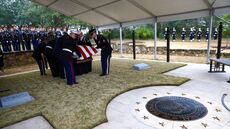
President Bush's casket arrives at his burial site in Torrington National Cemetery, in accordance with his wishes to be buried on American soil. The cemetery was rededicated as George Bush National Cemetery during the funeral ceremony.
In accordance with his final wishes to be buried on American soil, President Bush's body was transported to the US port city of Newport, Oregon, and then by train to the newly-opened National Cemetery in Wyoming near Torrington. The cemetery was rededicated as the George Bush National Cemetery. The state funeral was attended by members of the Bush family, former President Jimmy Carter (who had traveled from Neonotia for the occasion), and the current US President.
Legacy[]
President Bush is remembered by the general public and historians for his efforts against titanic odds during the post-Doomsday years to provide leadership and cohesion to the American people, at a time when many were scattered across the Pacific and those in the homeland were cut off from one another. Bush's efforts as Vice President alongside President Reagan are agreed by historians to have helped lay the groundwork for the continuation of US governance on the mainland, and his efforts as President in the Pacific at the helm of the American Provisional Administration provided desperately-needed structure and leadership to the American diaspora. Although public opinion of President Bush became sharply divided among Americans following his reluctant dissolution of the APA, his personal efforts at providing concrete structures to maintain American culture (such as umbrella organizations promoting American food, sports, and media) earned continued respect, and books such as "The Last American President" were emblematic of the public's majority-favorable sentiment towards Bush . In the final decade of his life, his steadfast support for the Torrington-based US government managed to win back the approval of Americans on the mainland. In his final years, he was seen as the elder statesman of the American people, and worked tirelessly to promote the peaceful reintegration of the American diaspora.
| ||||||||||||||||||||||

